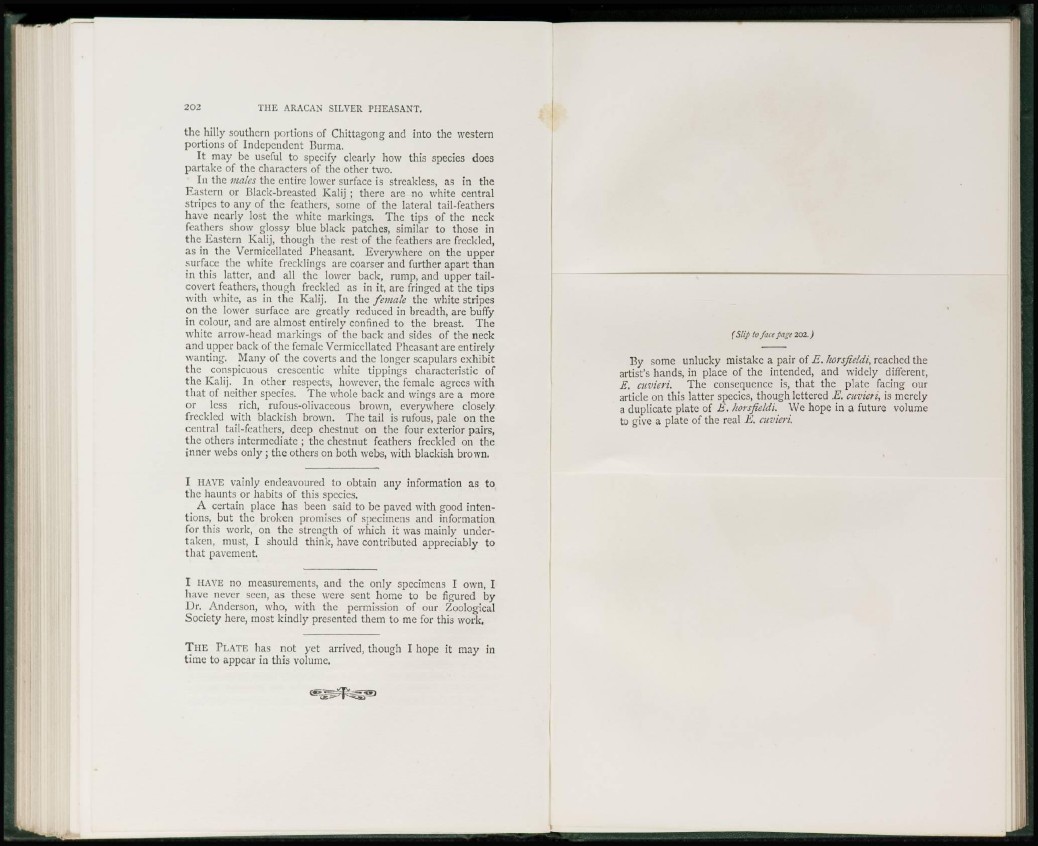
the hilly southern portions of Chittagong and into the western
portions of Independent Burma.
I t may be useful to specify clearly how this species does
partake of the characters of the other two.
In the males the entire lower surface is streakless, as in the
Eastern or Black-breasted Kalij ; there are no white central
stripes to any of the feathers, some of the lateral tail-feathers
have nearly lost the white markings. The tips of the neck
feathers show glossy blue black patches, similar to those in
the Eastern Kalij, though the rest of the feathers are freckled,
as in the Vermicellated Pheasant. Everywhere on the upper
surface the white frccklings are coarser and further apart than
in this latter, and all the lower back, rump, and upper tailcovert
feathers, though freckled as in it, are fringed at the tips
with white, as in the Kalij. In the female the white stripes
on the lower surface arc greatly reduced in breadth, arc buffy
in colour, and are almost entirely confined to the breast. The
white arrow-head markings of the back and sides of the neck
and upper back of the female Vermicellated Pheasant are entirely
wanting. Many of the coverts and the longer scapulars exhibit
the conspicuous cresccntic white tippings characteristic of
the Kalij. In other respects, however, the female agrees with
that of neither species. The whole back and wings are a more
or less rich, rufous-olivaccous brown, everywhere closely
freckled with blackish brown. The tail is rufous, pale on the
central tail-feathers, deep chestnut on the four exterior pairs,
the others intermediate ; the chestnut feathers freckled on the
inner webs only ; the others on both webs, with blackish brown.
I HAVE vainly endeavoured to obtain any information as to
the haunts or habits of this species.
A certain place has been said to be paved with good intentions,
but the broken promises of specimens and information
for this work, on the strength of which it was mainly undertaken,
must, I should think, have contributed appreciably to
that pavement.
I HAVE no measurements, and the only specimens I own, I
have never seen, as these were sent home to be figured by
Dr. Anderson, who, with the permission of our Zoological
Society here, most kindly presented them to me for this work.
T H E PLATE Iras not yet arrived, though I hope it may in
time to appear in this volume.
(Slip to face page 202.)
By some unlucky mistake a pair of E. horsfieldi, reached the
artist's hands, in place of the intended, and widely different,
E. cuvieri. The consequence is, that the plate facing our
article on this latter species, though lettered E. cuvieri, is merely
a duplicate plate of E. horsfieldi. We hope in a future volume
to give a plate of the real E. cuvieri.